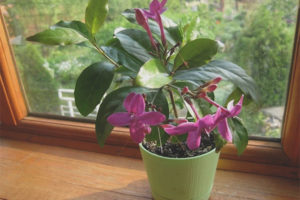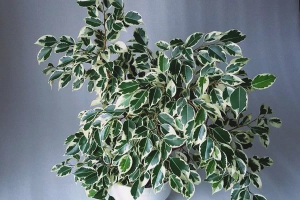The content of the article
Pruning dracaena is sanitary and decorative. In the first case, rotten and dried parts of the bush, as well as leaves and roots damaged by insects or mold, are removed. In the second, a part of the mother trunk is cut to stimulate the growth of lateral shoots and leaves. Crohn's dracaena becomes thick and lush. Removing the sick and healthy parts of the decorative bush is carried out with the right tool and at a strictly defined time, otherwise the plant will weaken and die.
Spring or fall
Pruning shoots is stressful for dracaena. It takes a plant time to heal the wounds and recover. Removal is not carried out in the autumn and winter months. Around October, a decorative bush is preparing for hibernation and cold weather. If you deprive him of part of the mother’s trunk, the immunity of an exotic flower will weaken, and it will become an ideal object for attack by fungi and insects. The exception is sanitary pruning. Rotten and dried leaves, as well as branches, are cleaned at any time of the year to protect the bush from the further spread of infection.
Decorative pruning is carried out in mid-spring. Sometimes the procedure is postponed to May or early June. Dracaena, awakened from winter sleep, actively grows and produces a lot of juice. Any damage is quickly delayed, and fresh kidneys form at the site of the removed maternal trunk.
It is not recommended to trim the dracaena in the middle or end of summer, when the air temperature rises and the humidity drops. The ground in the hill and the root system are constantly drying up, the flower becomes vulnerable. Dracaena, weakened by heat, after removal of shoots will not be able to withstand spider mites and other pests.
In winter, trim decorative bushes with broken tops. If part of the trunk fell away due to mechanical damage, trim the remaining wound with a sharp knife or scissors. Torn edges slow down and complicate healing. But when pruning in winter, dracenes provide full watering, proper lighting and recharge.
Instruments
The decorative bush is unpretentious and hardy, but even it can die if bacteria or rust from the knife get into the wound. Pruning a room palm is carried out with clean and sharpened tools. A pruner, regular scissors or a kitchen knife will do. Wear medical gloves or rubber for washing dishes. During the procedure, sterile cotton wool and a bottle of antiseptics should be at hand:
- peroxides;
- ethyl alcohol;
- tinctures of calendula or eucalyptus;
- Chlorhexidine.
If nothing suitable was found, use vodka. The tool blade is wiped with an antiseptic after removing each part of the plant. It is forbidden to use rusty or blunt knives that cannot cut off the shoot the first time. Poor quality tools injure the plant, slowing its recovery. After incorrect trimming, deformed shoots are formed.
An open wound is an ideal medium for the growth of bacteria. A fresh slice must be sprinkled with activated or charcoal. The workpiece has antiseptic and drying properties.
The coal powder is replaced with a paraffin candle. Melted wax burns wounds and protects against microbial contamination. After processing with paraffin, the cut site is wrapped with moss. Sphagnum has a porous structure, due to which it retains moisture and creates favorable conditions for the formation of healthy and strong kidneys.
Growth stimulants accelerate healing. Make-up is added to spray water. The most common drug designed to treat dracen is called Zircon.
Step-by-step instruction
The decorative bush is trimmed when:
- he has one stalk with few leaves;
- young shoots are deformed;
- plant height exceeds 2–2.5 m.
10-15 cm recede from the top of the dracaena. It is possible more if the owner of the plant needs a neat and squat flower. The main thing is to leave a stump that protrudes 20-25 cm above the substrate.
Instruments are disinfected immediately before the procedure. A sharp secateurs remove the selected part of the decorative bush. If it was not possible to cut off the mother trunk the first time, it cannot be broken by hand. Parts that have not separated from the flower are cut off with a sharpened knife. A sharp blade leaves even wounds without torn edges.
The next stage is the cleansing of the remaining stem from the leaves. 10 cm recede from the stump, leaving only the bark. The buds, shoots and leaves growing on this stretch are removed with a knife.
Gardeners who choose charcoal or activated carbon as an antiseptic, grind it in advance in a mortar. Powder abundantly sprinkled with a fresh slice. Processing can be repeated several times until the dracaena wound dries.
If instead of activated carbon, the owner of the flower settled on a paraffin candle, not only a lighter, but also a disposable plastic knife will come in handy. Cutlery allows you to control where the molten wax gets. Drops of liquid paraffin leave burns on the leaves of dracaena. The lower part of the plant, on which the greens remained, can be closed with a plastic bag. The cover is removed after cauterization.
Around the dried slice wrap sphagnum. A thick layer of moss is fixed on the trunk with rubber bands or ribbons. A cellophane bag is put on top, the edges are tied around the appendix. A polyethylene cover is removed once a week, so that the mother trunk gets access to oxygen.
The package and sphagnum create a humid tropical climate that stimulates the growth of new buds. The first shoots look like small droplets or peas. If they appeared on the stem, dracaena no longer needs moss and a plastic cover.
A decorative bush spends a lot of fluid when forming kidneys. The substrate in which the dracaena lives is moistened daily with a spray gun. A few drops of a growth promoter are added to the water. After the shoots appear, the recharge is removed.
Care after trimming
Removed dracaena parts do not have to be thrown away. Preparations can be sprouted in a glass of warm water or a container with sphagnum. Sprouts that have acquired their own roots are planted in the pot in which the mother stem lives, or a new small pot.
Dracaena after decorative trimming is hidden from direct ultraviolet radiation. Indoor flower is restored in the dark at a temperature of + 24-26 degrees. Until the cut is tightened, it is forbidden to add fertilizers to the water for irrigation. The exception is growth stimulant.
The ornamental bush on which young shoots have formed is returned to the southern windowsill. Sunlight stimulates kidney growth. In order for the shoots to develop evenly, the pot is periodically rotated clockwise. Thanks to this, the sun will fall on all parts of the bush. If the shoots are deformed due to improper light conditions, they are cut off next spring or summer, so that straight specimens with dense foliage grow on the site of ugly twigs.
Dracaena belongs to the group of unpretentious and hardy indoor flowers. But even such a strong plant needs care and timely pruning. Stem removal is carried out with clean and sharp tools, and antiseptics are used after the procedure. Coal and paraffin protect Dracaena from infection, and sphagnum and recharge stimulate the emergence of new shoots.
Video: pruning and cropping of dracaena











Submit